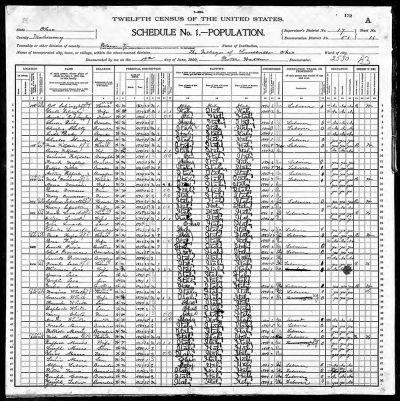Using U.S. Census records to discover your Italian ancestor’s early life in America can be both exhilarating and frustrating! Census records hold a wealth of information about your ancestors such as when they came to America, their age, place of birth, immigration dates, citizenship status, occupation, other family members or residents in the household, where they lived, and even whether they owned a home or rented. For Italian Americans researching our family roots, census records provide a glimpse into our ancestors’ lives every ten years. You can see how your family prospered or struggled by looking through the decades of census records available. However, sometimes it can be incredibly frustrating trying to find our ancestors’ census records – because of how their surnames were recorded! This month we are going to explore information in census records and how to overcome obstacles in finding your famiglia.
We will focus on the 1880 through the 1940 censuses, since these records cover the period when most of our Italian ancestors made their homes in America. Census records for 1890 are no longer available as they were destroyed in a 1921 fire at the Commerce Department. Fortunately, the loss of the 1890 census is usually not an obstacle with peak Italian immigration occurring in the 20th century. You can research census records at www.familysearch.org (create a free account to view images) or if you have a subscription, check out www.ancestry.com (many local libraries also offer a free library edition of Ancestry on their computers).
Italian surnames can be difficult to find in census records due to the way the records were created and transcribed for online research. Many of the early census takers were not familiar with Italian names; nor were they able to spell a name that they heard spoken with a strong Italian accent. Additionally, many of our ancestors had limited education and were not able to spell their names for the census taker. Therefore, the census taker simply wrote down what he or she heard which resulted in “butchered” names. Even when a census taker got the name correct, if he or she had terrible handwriting, at the transcription step, it may be recorded wrong. All of these issues are how an Italian name like Filomena Esarco becomes Philmena Yesacco in a transcribed census record.
There are ways to find a census record even if a surname is misspelled or transcribed incorrectly. You just need to search in different ways. If your ancestor or a household member had a unique first name, you can try searching by first name only and location, leaving the surname field blank. Also, try searching with nicknames, like “Tony” for “Antonio.” Another option is if you know your ancestor lived next to another family for many years, you can try searching for that family and pull up the census image to look at the families who are listed on the same page or the pages before or after. Sometimes the names are so butchered that you will need to search using just three fields, approximate age, sex and location. At that point, you will have to go painstakingly through the search results to see if there are any close matches.
All censuses collected standard information as described above but in some years, there were questions that are very useful in yielding clues to your family’s history. For example, the 1900, 1910, 1920, and 1930 censuses show the year of immigration. Here is a chart by census year and the unique genealogically valuable information reported in addition to the basic questions in all census records.
| Census Year | Genealogically Valuable Census Questions |
| 1880 | What was the person’s father’s/mother’s place of birth? |
| 1900 | What was the person’s father’s/mother’s place of birth? What year did the person immigrate to the U.S.? How many years has the person been in the U.S.? Is the person naturalized? Can the person speak English? |
| 1910 | Place of birth of the person’s father/mother? Year of immigration to the U.S.? Is the person naturalized or an alien? Can the person speak English? If not, what language does the person speak? |
| 1920 | Year of immigration to the U.S.? Is the person naturalized or alien? If naturalized, what was the year of naturalization? Person’s father’s/mother’s place of birth? Person’s father’s/mother’s mother tongue? |
| 1930 | Person’s father’s/mother’s place of birth? Year of immigration into the U.S.? Is the person naturalized or an alien? Is the person able to speak English? |
| 1940 | If foreign born, is the person a citizen? In what place did the person live on April 1, 1935? |
There is one caveat about reliance upon the information in a census record. The information is only as good as the knowledge or memory of the person who reported it to the census taker! For example, if your ancestor was a boarder and was at work when the census taker came to the door, it is likely the landlord provided the information and may not have reported it correctly. Bear this in mind when you are putting together your family history and always try to back up the information you find in the census record with another piece of evidence.



